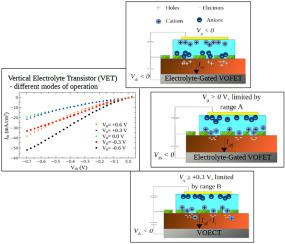当前位置:
X-MOL 学术
›
Curr. Appl. Phys.
›
论文详情
Our official English website, www.x-mol.net, welcomes your
feedback! (Note: you will need to create a separate account there.)
Fabrication and electrical characterization of Vertical Electrolyte Transistor
Current Applied Physics ( IF 2.4 ) Pub Date : 2020-11-01 , DOI: 10.1016/j.cap.2020.07.012 Keli Fabiana Seidel
Current Applied Physics ( IF 2.4 ) Pub Date : 2020-11-01 , DOI: 10.1016/j.cap.2020.07.012 Keli Fabiana Seidel

|
Abstract Here, it is reported a vertical electrolyte transistor (VET) whose structure is based on stacked layers: bottom contact → channel → permeable intermediate electrode → ion gel (electrolyte gate dielectric) → gate top contact. This VET depicts versatility to work with two different mode of operation, as: Electrolyte-Gated Vertical Organic Field Effect Transistor (Electrolyte-Gated VOFET) or Vertical Organic Electrochemical Transistor (VOECT). The difference is regarding to the transistor transconductance that occurs due to induced charge carriers or ionic current, respectively. Here, the focus is on giving special attention to the electrical characterization of the VET diode cell in comparison to the VET full architecture. These measurements are able to provide the baseline output current from a VET and consequently distinguish it from possibles different modes of operation created by ionic species. Both modes of operation show that this VET is able to work at very low voltage range and drive a high current density.
中文翻译:

垂直电解质晶体管的制造和电气特性
摘要 这里报道了一种垂直电解质晶体管(VET),其结构基于堆叠层:底部接触→通道→可渗透中间电极→离子凝胶(电解质栅极电介质)→栅极顶部接触。此 VET 描述了使用两种不同操作模式的多功能性,例如:电解质门控垂直有机场效应晶体管(电解质门控 VOFET)或垂直有机电化学晶体管 (VOECT)。不同之处在于分别由于感应电荷载流子或离子电流而发生的晶体管跨导。在这里,重点是特别关注 VET 二极管单元与 VET 完整架构相比的电气特性。这些测量能够提供来自 VET 的基线输出电流,从而将其与由离子种类产生的可能的不同操作模式区分开来。两种操作模式都表明该 VET 能够在非常低的电压范围内工作并驱动高电流密度。
更新日期:2020-11-01
中文翻译:

垂直电解质晶体管的制造和电气特性
摘要 这里报道了一种垂直电解质晶体管(VET),其结构基于堆叠层:底部接触→通道→可渗透中间电极→离子凝胶(电解质栅极电介质)→栅极顶部接触。此 VET 描述了使用两种不同操作模式的多功能性,例如:电解质门控垂直有机场效应晶体管(电解质门控 VOFET)或垂直有机电化学晶体管 (VOECT)。不同之处在于分别由于感应电荷载流子或离子电流而发生的晶体管跨导。在这里,重点是特别关注 VET 二极管单元与 VET 完整架构相比的电气特性。这些测量能够提供来自 VET 的基线输出电流,从而将其与由离子种类产生的可能的不同操作模式区分开来。两种操作模式都表明该 VET 能够在非常低的电压范围内工作并驱动高电流密度。











































 京公网安备 11010802027423号
京公网安备 11010802027423号